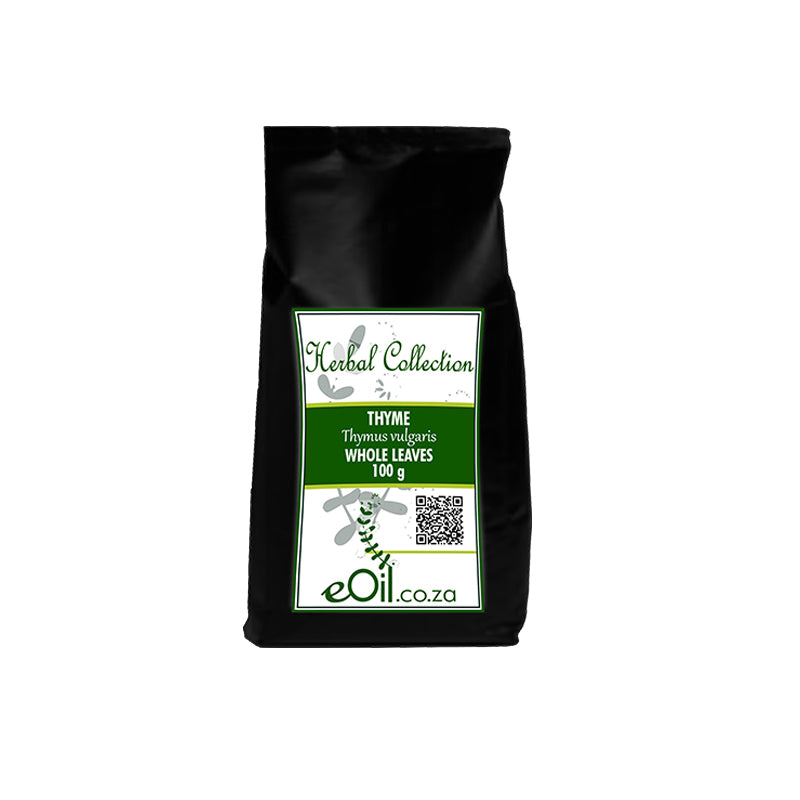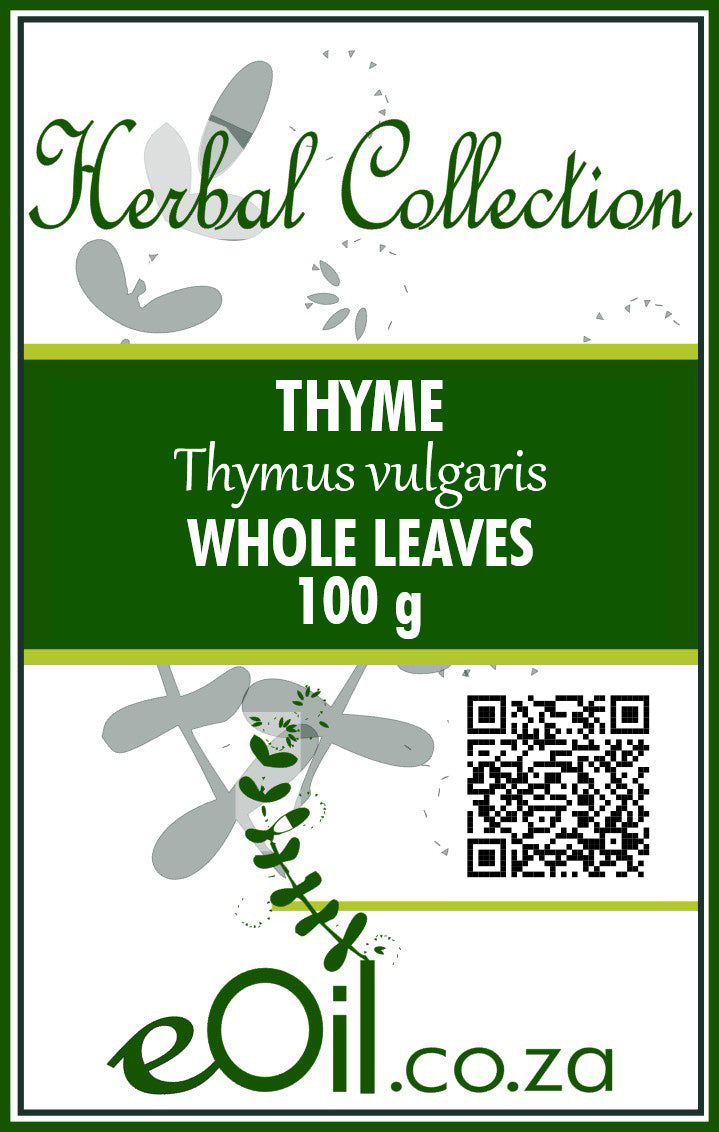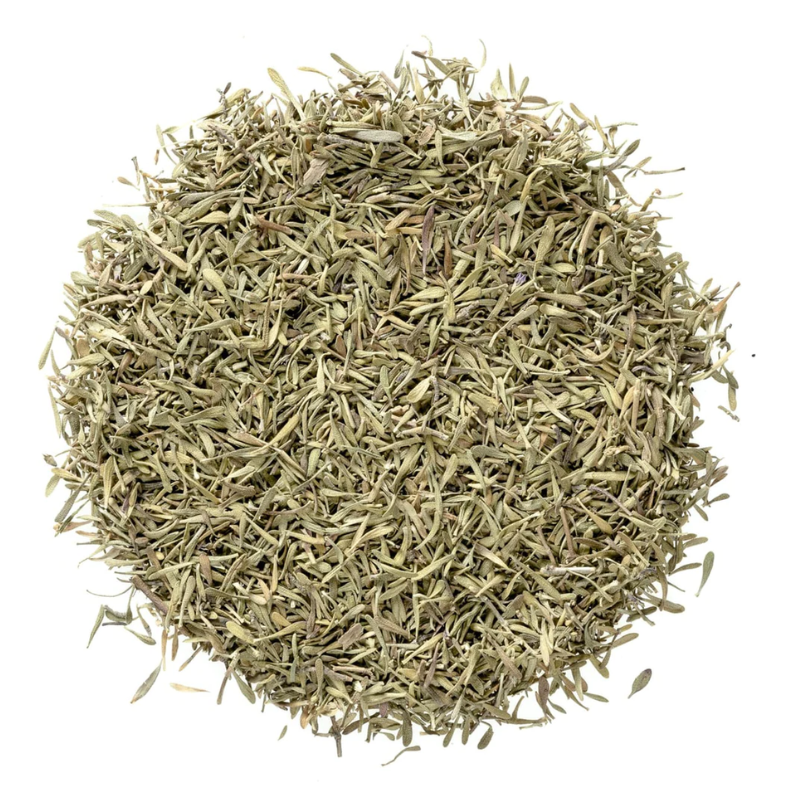Thyme ( Thymus Vulgaris ) Whole leaves Dried - Herbal Collection
Thyme ( Thymus Vulgaris ) Whole leaves Dried - Herbal Collection - 100 GR is backordered and will ship as soon as it is back in stock.
Description
Description
It's commonly used to season soups, sauces and is a perfect addition in potatoes, rice dishes, vegetables, and even fresh bread. And it pairs well with other Mediterranean herbs like oregano and marjoram, and is used throughout Italian, French, and of course, Mediterranean cooking
thyme is packed with vitamin C and is also a useful source of vitamin A. If you feel a cold coming on, thyme can help get you back in good health. Another health benefit of thyme: It's a source of copper, fiber, iron, and manganese
Thyme cut leaves dried vs Thyme Powder vs Thyme essential oils
INFORMATION
Source : http://www.wikiphyto.org/wiki/Thyme
Reference on http://www.wikiphyto.org
Translation in English by Google Translate (go to the page of the source linked | on Chrome cellphones go on the 3 dots on the top right and select translate in your preferred language | on laptop right click your mouse and select option translate when hoovering on the page
plant name
Thyme, common thyme , farigoule , farigoulette
International Latin denomination
Thymus vulgaris L. (and Thymus zigis for the French Pharmacopoeia )
botanical family
Lamiaceae
Description and habitat
- Perennial and very aromatic sub-shrub of Mediterranean scrubland and maquis, with branched stems, small very fragrant, opposite, linear and lanceolate leaves, sessile
- The bilabiate pink flowers, very melliferous, are united in globular terminal spikes
History and tradition
- The ancient Greeks used thyme as incense in their temples
- The potion made from thyme was believed to give courage and bravery for battles ( Thumos means courage in Greek)
- Pliny already recommended it as an anti-infective
- In the Middle Ages, it entered into the composition of some potions intended to see the fairies, and cured torticollis
- Vulnerable species or Swiss tea from the 1949 Codex:
- Leaves and tops of wormwood , betony , calamentum , germander , hyssop , ground ivy , oregano , periwinkle , rosemary , sage , scolopendra , scordium , thyme , veronica ; arnica flowers , cat's foot , coltsfoot ; in equal parts
- Thymus zygis is a Spanish variety of Thymus vulgaris
Parts used
- Flowering aerial parts
- Flowering plant essential oil
Dosage forms available
- Mother tincture of aerial parts
- Flowering tops essential oil
Usual dosages
Composition
Main components of the plant
- Essential oil of very variable composition, with numerous chemotypes which give a biochemical and most often therapeutic specificity to each of them
- Flavonoids , flavones ( apigenin ), polymethoxyflavones
- Phenol acids
- Pentacyclic triterpenes : oleanolic acid , ursolic acid
- Polysaccharides
Main components of buds or young shoots
Main components of essential oil
For the thymol chemotype :
- Monoterpene phenols : thymol 50%, carvacrol
- Monoterpenes : paracymene , myrcene , gamma-terpinene , alpha-terpinene , beta-caryophyllene
- Monoterpene alcohols : terpinene-4-ol , borneol , linalool
- Sesquiterpènes : béta-caryophyllène, lédène, alloaromadendrène
Properties
Plant properties
- Powerful anti-infective [2] used mainly in bronchopulmonary and ENT diseases [3] , digestive, upper and lower renal, potentiation of HE and methanolic extract of Thymus vulgaris and Pimpinella anisum vis of Staphylococcus aureus , Bacillus cereus , Proteus vulgaris [4]
- Antifungal [5] especially by thymol on Aspergillus , inhibitor of the production of aflatoxins, potentiates the effect of amphotericin B on Candida albicans [6]
- Antiviral activity against Herpes virus [7] , [8]
- Powerful antioxidant [9] ( polymethoxyflavones , thymol , rosmarinic acid ) and anti-aging, inhibits protein glycation [10]
- Anti-inflammatory by action on NO inhibition and antiradical effects [11]
- Polysaccharides are complement activators [12]
- Cardiac tonic (by the triterpenes oleanolic acid , ursolic acid )
- General tonic, adrenocortical stimulant
- Immunomodulating, stimulates the proliferation of dendritic cells but reduces that of T lymphocytes [13] , thymol appears to be immunosuppressive [14]
- Bronchial spasmolytic [15] , cough suppressant, muscle relaxant
- Expectorant
- Vermifuge
Bud properties
Properties of essential oil
- Potent broad-spectrum antimicrobial, antibacterial, antiviral, antifungal [16] , antiparasitic [17] , such as HE from Thymus zygis and Thymus hyemalis [18]
- The majority of chemotypes are anti-infective, regardless of their major component ( geraniol , thujanol , terpinene-4-ol , thymol , linalool ), against Gram-positive bacteria ( Brocothrix thermosphacta , Staphylococcus aureus , Streptococcus mutans [19] ), Gram-negative ( Escherichia coli , Salmonella abony , Pseudomonas aeruginosa , Pseudomonas fragi ) [20]
- Synergy with antibiotics, especially against resistant germs ( Staphylococcus aureus resistant to methicillin MRSA [21] , Streptococcus pneumoniae , Salmonella enteritidis , Salmonella typhimurium ) and Helicobacter pylori , antibacterial against Enterococcus and Vancomycin resistant Escherichia coli O157:H7 [22]
- Thymol and carvacrol are inhibitors of bacterial efflux pumps, especially in synergistic combination [23]
- Anti-bacterial biofilm, Chinese cinnamon , clove , tea tree , balsam of Peru and red thyme essential oils are more effective in eradicating biofilms of Pseudomonas and Staphylococcus aureus than certain antibiotics, which constitutes a huge potential for the discovery of alternatives or complements to antibiotics [24]
- Antibacterial synergies between EOs of common thyme and myrtle ( Staphylococcus aureus , Escherichia coli ) [25]
- Thymol and carvacrol are bacteriostatic and bactericidal against Escherichia coli [26] and Shigella sp [27] , especially in ethanolic or stabilizing solutions such as agar-agar or carrageenans .
- Monoterpenes ( menthol , thymol , linalyl acetate ) are antibacterial by action on the lipid fraction of the bacterial membrane [28]
- Thymol antifungal against Candida albicans , Aspergillus and inhibitor of aflatoxin production [29]
- Tonic, general stimulant
- Digestive, carminative, apéritive, cholagogue
- Revulsive, reddening
- immune booster
- Cytotoxic to cancer cells (OCSCC squamous cell carcinoma of the oral cavity) [31]
- Antioxidant [32]
- At least 7 chemotypes or chemotypes are described , the most common of which are:
Indications
Indications of the whole plant (phytotherapy)
- Bronchitis, whooping cough, pleurisy
- Flu
- Anti-bacterial against Helicobacter pylori
- Small heart defects ( oleanolic acid , ursolic acid )
Indications of the bud (gemmotherapy)
Specific indications of essential oil (aromatherapy)
- Helicobacter pylori ulcers
- Flu, bronchitis, pneumonia, whooping cough, pleurisy, nasopharyngitis, sinusitis
- Dysentery, infectious diarrhea, amoebiasis
- Intestinal and cutaneous parasites (scabies, ringworm)
- Sciatica, lumbago, osteoarthritis, rheumatism by external rubefacient effect
- General fatigue, depression
Known or suspected mode of action
- The antimicrobial effect of thymol results from an interaction between the phenolic constituents of HE and the lipid and protein fractions of bacterial plasma membranes [33] , antifungal ( Candida , Aspergillus ) and inhibitor of the production of aflatoxins, potentiates the effect of amphotericin B on Candida albicans , synergistic with antibiotics especially against resistant germs
- Antioxidant, neutralization of free radicals and reactive forms of oxygen: phenols such as thymol have redox properties, active on GABA membrane receptors
Usual formulations
Regulations
- French Pharmacopoeia list A (leaf, flowering top of Thymus vulgaris and Thymus zigis )
Possible side effects and precautions for use
- Avoid in case of hypertension and tachycardias
- Essential oil not recommended for children under 6 and pregnant and breastfeeding women
- Skin irritation (dermocaustic) possible in pure form
- Thymol only presents a toxic risk at very high doses, allergies are very rare
Bibliographic references
- Go↑ Elisabeth Stahl-Biskup. The Chemical Composition of Thymus Oils: A Review of the Literature 1960–1989. Journal Of Essential Oil Research Vol. 3 , Iss. 2,1991, pages 61-82 [1]
- Go↑ A. Tohidpour, M. Sattari, R. Omidbaigi, A. Yadegar, J. Nazemi. Antibacterial effect of essential oils from two medicinal plants against Methicillin-resistant Staphylococcus aureus (MRSA). Phytomedicine, Volume 17, Issue 2, February 2010, Pages 142-145. [2]
- Go↑ Inouye S, Yamaguchi H, Takizawa T. Screening of the antibacterial effects of a variety of essential oils on respiratory tract pathogens, using a modified dilution assay method. Journal of Infection and Chemotherapy, 2001a, 7 pp. 251-254
- Go↑ Al-Bayati FA. Synergistic antibacterial activity between Thymus vulgaris and Pimpinella anisum essential oils and methanol extracts. J Ethnopharmacol. 2008 Mar 28;116(3):403-6. PMID 18226481
- Go↑ Soković MD, Vukojević J, Marin PD, Brkić DD, Vajs V, van Griensven LJ. Chemical composition of essential oils of Thymus and Mentha species and their antifungal activities. Molecules. 2009 Jan 7;14(1):238-49. PMID 19136911
- Go↑ Giordani R, Regli P, Kaloustian J, Mikail C, Abou L, Portugal H. Antifungal effect of various essential oils against Candida albicans. Potentiation of antifungal action of amphotericin B by essential oil from Thymus vulgaris. Phytother Res. 2004 Dec;18(12):990-5. PMID 15742351 [3]
- Go↑ Schnitzler P, Koch C, Reichling J. Susceptibility of drug-resistant clinical herpes simplex virus type 1 strains to essential oils of ginger, thyme, hyssop, and sandalwood. Antimicrob Agents Chemother. 2007 May;51(5):1859-62. PMID 17353250
- Go↑ Nolkemper S, Reichling J, Stintzing FC, Carle R, Schnitzler P. Antiviral effect of aqueous extracts from species of the Lamiaceae family against Herpes simplex virus type 1 and type 2 in vitro. Planta Med. 2006 Dec;72(15):1378-82. PMID 17091431
- Go↑ Chizzola R, Michitsch H, Franz C. Antioxidative properties of Thymus vulgaris leaves: comparison of different extracts and essential oil chemotypes. J Agric Food Chem. 2008 Aug 27;56(16):6897-904. PMID 18656929
- Go↑ Morimitsu Y, Yoshida K, Esaki S, Hirota A. Protein glycation inhibitors from thyme (Thymus vulgaris). Bioscience, biotechnology, and biochemistry, 1995, vol. 59, no11, pp. 2018-2021 [4]
- Go↑ Vigo E, Cepeda A, Gualillo O, Perez-Fernandez R. In-vitro anti-inflammatory effect of Eucalyptus globulus and Thymus vulgaris: nitric oxide inhibition in J774A.1 murine macrophages. J Pharm Pharmacol. 2004 Feb;56(2):257-63. PMID 15005885
- Go↑ Hyug Chun, Dong Hoon Shin, Bum Shik Hong Hong Yon Cho, Han Chul Yang. Purification and Biological Activity of Acidic Polysaccharide from Leaves of Thymus vulgaris L. Biol. Pharm. Bull. 24(8) 941—946 (2001)texte intégral
- Go↑ Amirghofran Z, Ahmadi H, Karimi MH. Immunomodulatory activity of the water extract of Thymus vulgaris, Thymus daenensis, and Zataria multiflora on dendritic cells and T cells responses. J Immunoassay Immunochem. 2012;33(4):388-402. doi: 10.1080/15321819.2012.655822. PMID 22963488
- Go↑ Amirghofran Z, Hashemzadeh R, Javidnia K, Golmoghaddam H, Esmaeilbeig A. In vitro immunomodulatory effects of extracts from three plants of the Labiatae family and isolation of the active compound(s). J Immunotoxicol. 2011 Oct-Dec;8(4):265-73. doi: 10.3109/1547691X.2011.590828. PMID 21711089
- Go↑ Meister A, Bernhardt G, Christoffel V, Buschauer A. Antispasmodic activity of Thymus vulgaris extract on the isolated guinea-pig trachea: discrimination between drug and ethanol effects. Planta Med. 1999 Aug;65(6):512-6. PMID 10483369
- Go↑ Pozzatti P, Scheid LA, Spader TB, Atayde ML, Santurio JM, Alves SH. In vitro activity of essential oils extracted from plants used as spices against fluconazole-resistant and fluconazole-susceptible Candida spp. Can J Microbiol. 2008 Nov;54(11):950-6. PMID 18997851
- Go↑ Lisin, G., Safiyev, S. and Craker, L.E. 1999. Antimicrobial activity of some essential oils. Acta Hort. (ISHS) 501:283-288. http://www.actahort.org/books/501/501_45.htm
- Go↑ Rota Maria C, Herrera Antonio, Martinez Rosa M, Sotomayor Jose A, Jordan Maria J. Antimicrobial activity and chemical composition of Thymus vulgaris, Thymus zygis and Thymus hyemalis essential oils. Food control, 2008, vol. 19, no7, pp. 681-687 [5]
- Go↑ Schött G, Liesegang S, Gaunitz F, Gleß A, Basche S, Hannig C, Speer K. The chemical composition of the pharmacologically active Thymus species, its antibacterial activity against Streptococcus mutans and the antiadherent effects of T. vulgaris on the bacterial colonization of the in situ pellicle. Fitoterapia. 2017 Sep;121:118-128. doi: 10.1016/j.fitote.2017.07.005. PMID 28705510
- Go↑ Schmidt E, Wanner J, Hiiferl M, Jirovetz L, Buchbauer G, Gochev V, Girova T, Stoyanova A, Geissler M. Chemical composition, olfactory analysis and antibacterial activity of Thymus vulgaris chemotypes geraniol, 4-thujanol/terpinen-4-ol, thymol and linalool cultivated in southern France. Nat Prod Commun. 2012 Aug;7(8):1095-8. PMID 22978238
- Go↑ Tohidpour A, Sattari M, Omidbaigi R, Yadegar A, Nazemi J. Antibacterial effect of essential oils from two medicinal plants against Methicillin-resistant Staphylococcus aureus (MRSA). Phytomedicine. 2010 Feb;17(2):142-5. doi: 10.1016/j.phymed.2009.05.007. PMID 19576738
- Go↑ Selim S. Antimicrobial activity of essential oils against vancomycin-resistant enterococci (vre) and Escherichia coli o157:h7 in feta soft cheese and minced beef meat. Braz J Microbiol. 2011 Jan;42(1):187-96. doi: 10.1590/S1517-83822011000100023. PMID 24031620
- Go↑ Miladi H, Zmantar T, Chaabouni Y, Fedhila K, Bakhrouf A, Mahdouani K, Chaieb K. Antibacterial and efflux pump inhibitors of thymol and carvacrol against food-borne pathogens. Microb Pathog. 2016 Oct;99:95-100. doi: 10.1016/j.micpath.2016.08.008. PMID 27521228
- Go↑ Kavanaugh, N. L., & Ribbeck, K. (2012). Selected antimicrobial essential oils eradicate Pseudomonas spp. and Staphylococcus aureus biofilms. Appl. Environ. Microbiol., 78(11), 4057-4061.
- Go↑ Sadiki, Moulay & Balouiri, Mounyr & Barkai, Hassan & Maataoui, Hajar & Saad, Ibnsouda & EL ABED, Soumya. (2014). Synergistic antibacterial effect of Myrtus communis and Thymus vulgaris essential oils fractional inhibitory concentration index. International Journal of Pharmacy and Pharmaceutical Sciences. 1.
- Go↑ Marino M, Bersani C, Comi G. Antimicrobial Activity of the Essential Oils of Thymus vulgaris L. Measured Using a Bioimpedometric Method. Journal of Food Protection, 1999, 62 (9), pp. 1017-1023(7) [6]
- Go↑ C. F. Bagamboula, M. Uyttendaele, J. Debevere. Inhibitory effect of thyme and basil essential oils, carvacrol, thymol, estragol, linalool and p-cymene towards Shigella sonnei and S. flexneri. Food Microbiology, Volume 21, Issue 1, February 2004, Pages 33-42
- Go↑ Trombetta D, Castelli F, Sarpietro MG, Venuti V, Cristani M, Daniele C, Saija A, Mazzanti G, Bisignano G. Mechanisms of antibacterial action of three monoterpenes. Antimicrob Agents Chemother. 2005 Jun;49(6):2474-8. PMID 15917549 Texte intégral
- Go↑ Rasooli I, Owlia P. Chemoprevention by thyme oils of Aspergillus parasiticus growth and aflatoxin production. Phytochemistry. 2005 Dec;66(24):2851-6
- Go↑ Giordani, R., Regli, P., Kaloustian, J., Mikail, C., Abou, L., & Portugal, H. (2004). Antifungal effect of various essential oils against Candida albicans. Potentiation of antifungal action of amphotericin B by essential oil from Thymus vulgaris. Phytotherapy Research, 18(12), 990-995.
- Go↑ Sertel S, Eichhorn T, Plinkert PK, Efferth T. Cytotoxicity of Thymus vulgaris essential oil towards human oral cavity squamous cell carcinoma. Anticancer Res. 2011 Jan;31(1):81-7. PMID 21273584
- Go↑ Seung-Joo Lee, Katumi Umano, Takayuki Shibamoto, Kwang-Geun Lee. Identification of volatile components in basil (Ocimum basilicum L.) and thyme leaves(Thymus vulgaris L.) and their antioxidant properties. Food Chemistry 91 (2005) 131–137 texte intégral
- Go↑ Juven BJ, Kanner J, Schved F, Weisslowicz H. Factors that interact with the antibacterial action of thyme essential oil and its active constituents. J Appl Bacteriol. 1994 Jun;76(6):626-31. PMID 8027009
CAUTION
Store in a cool, dry place, away from light. Keep tightly closed, away from the reach of Children and pets.
Do not exceed the daily dose.
This product is not intended to prevent or cure any form of illness or disease.
If you are pregnant or nursing ; If you have a medical condition or are in the course of medical treatment ; If you are programmed for theater/operation in the near future, please consult your healthcare practitioner before using this product.
This product cannot replace a varied and balanced diet and a healthy lifestyle.
This product has not been evaluated by the SAHPRA for its quality, safety or intended use.
For More Information please check our General Safety Herbal products Page






